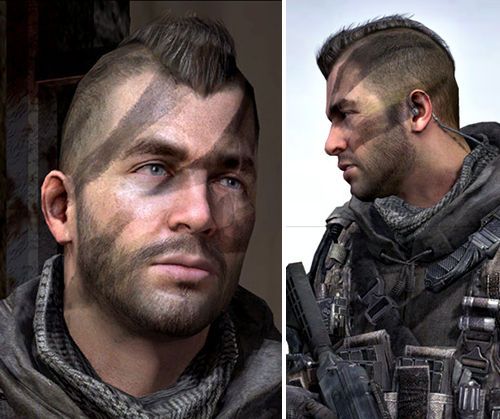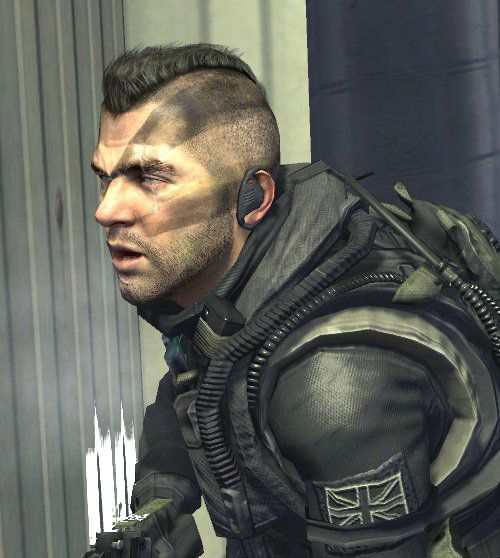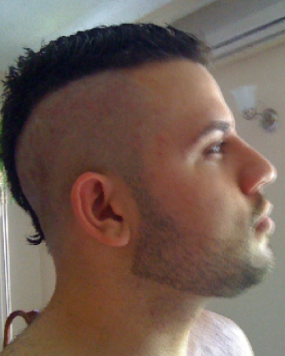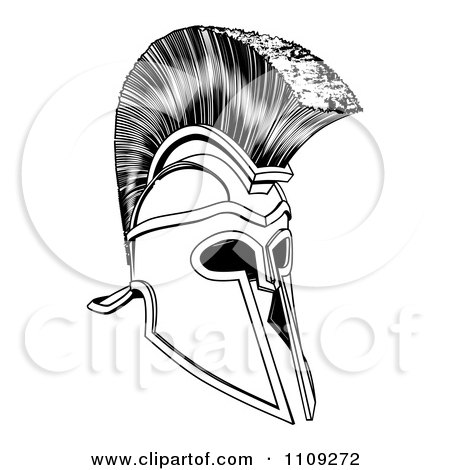[THIS IS JUST A BRIEF PREVIEW OF THE ARTICLE, "THE SECRET MILITARY HISTORY OF THE MOHAWK HAIRCUT." TO READ THE COMPLETE, MUCH LONGER ARTICLE WITH A HUGE ARRAY OF RARE, HISTORICAL PHOTOS OF MILITARY MEN WEARING MOHAWKS, CLICK HERE.
Many Americans will be amazed to learn that it was courageous U.S. Army paratroopers who first popularized the Mohawk haircut more than 70 years ago during the Normandy Invasion on D-Day -- long before it was copied by punk rockers, football teams, and gutsy teenagers.
Just Google "Mohawk airborne" or "Mohawk D-Day"and you'll see a.lot of photos of those Mohawked paratroopers making history -- saving the world for democracy. I've posted a few of those historic photos on this Web page. Half of the men in these photos were either killed, wounded or captured in that combat jump -- but they accomplished their mission. They are legendary American heroes.
As a former paratrooper myself in the 82nd Airborne Division (a sergeant) ten years later during the Korean War, let me see if I can hopefully lend some clarity to the long-running debate on many Internet forums as to which individual airborne unit did -- or did not – introduce the Mohawk as a daringly distinctive (non-regulation) haircut for American paratroopers. I seem to be one of the few veterans still alive who remember the early military history of the Mohawk. So I guess I’d better write it down before we’re all dead. (The profile photo of me on this Web page shows me with a Mohawk shortly after I left the Army in 1955 when I was in my twenties.).
Back in the summer of 1954, I did an official, in-depth feature story on the military history of the Mohawk for the 82nd Airborne Division’s official radio program over a local civilian station in Fayetteville, NC, where Fort Bragg is located (home of the 82nd). What triggered the radio feature was the fact that summer maneuvers were underway at that time in the vast “pine barrens” of Fort Bragg’s back-country – and suddenly Mohawk haircuts began showing up on large numbers of 82nd troopers whenever they took their helmets off. People started asking: "What's the story behind the haircuts?" That made it suddenly newsworthy, resulting in my radio story.
In addition, I was recently asked to explain the history of paratrooper Mohawks when I was interviewed for the Library of Congress collection of videotaped interviews with veterans of American wars.
The bottom line is that – regardless of which airborne unit first adopted the startling haircut – it has, over the years, become as closely identified (unofficially) with Army paratroopers as the “high-and-tight” haircut is with U.S. Marines, despite the fact that it is not allowed by Army haircut regulations.
My old outfit, the 82nd Airborne Division, is sometimes erroneously credited with introducing the Mohawk to the military. It’s true that 82nd troopers periodically sported non-regulation Mohawks over the years when out in the field on maneuvers, including the years when I served with them. But photographic archives leave little doubt that the real credit for first introducing the Mohawk to the military belongs to another paratrooper outfit -- the legendary “Filthy 13” demolition unit of the 101st Airborne Division that parachuted behind Nazi lines in the pre-dawn hours before the Normandy Invasion on D-Day (June 6, 1944) in a courageous suicide mission.
Numerous D-Day photographs of that 101st Division demolition team show them boarding planes for the D-Day jump while wearing freshly shaved Mohawks and Native American war paint, supposedly designed to frighten the Nazis. Those eye-catching photographs were plastered across newspapers, movie newsreels and news magazines, including a famous photograph in the military newspaper, “Stars and Stripes” – introducing the entire world to that startling haircut and indelibly associating it forever with U.S. paratroopers.
One member of that 101st“Diivision demolition team was a Native American, and he has said that his mother suggested the haircut for the Normandy jump. Like most Americans, his mother was obviously aware that for the previous three or four years, American paratroopers had already been yelling “Geronimo” (the name of a famous Indian chief) as their colorful battle cry every time they jumped out of a plane. The haircut obviously fit the battle cry. His mother presumably figured if her son’s unit was going to yell like Indian warriors, they might as well look like Indian warriors.
Almost a year later, in March 1945, historic photographs show some paratroopers in a different division -- the now-defunct 17th Airborne Division – wearing similar Mohawks during a combat jump over Germany’s Rhine River. They undoubtedly had seen the earlier photograph of the 101st Division haircuts in “Stars and Stripes” and copied them – further cementing the haircut as a paratrooper tradition.
When the D-Day jump was recently re-enacted for the anniversary of the Normandy Invasion, the young paratroopers re-enacting that historic jump likewise shaved their heads into Mohawks for the sake of historical accuracy – a touching tribute and a tacit admission by the Army that this non-regulation haircut played a colorful role in military history.
I have never found any photographs showing any 82nd troopers with Mohawks during World War Two. But by the late 1940s or early 1950s, many 82nd paratroopers had likewise adopted the haircut as a strictly non-regulation, unofficial Airborne tradition when they were out in the field where commanders were less stringent about haircut regulations. (Mohawks were forbidden when in garrison.) It was a well-established but strictly unsanctioned tradition with the 82nd by the time I left the Army more than half a century ago.
As stated above, I saw hundreds of Mohawks among 82nd troopers during field maneuvers in the summer of 1954 when I served with them. I assumed that the commanding generals openly winked at the haircut regulations and quietly tolerated them while their men were out in the field. Otherwise the men would have been ordered to shave them off immediately. Actually, I strongly suspected that the generals secretly liked the Mohawks because they were a huge morale boost and added greatly to paratrooper esprit de corps – during the grim years of the Korean War when a morale boost was urgently needed. But the haircuts immediately disappeared when the troops returned to garrison.
In addition, I had a copy of an official Army souvenir booklet showing 82nd summer maneuvers a year or two prior to that, which amazingly had page after page showing entire regimental companies in large group shots – all of them with their heads shaved into Mohawks. That 1950s souvenir booklet even showed some company commanders (captains) with Mohawks, which seemed to give the haircuts a limited degree of semi-official sanction. Even more amazingly, the official Army booklet said the various companies in that particular regiment of the 82nd had held a contest to decide which company had the best Mohawks. That probably will surprise Veterans familiar with strict Army haircut regulations, but I can testify that it actually happened.
In addition, I also had a copy of an official Army yearbook of the 82nd participation in the April 1952 nuclear test at the Nevada Proving Grounds, which showed 82nd paratroopers crouched in foxholes as the nuclear device was exploded – many of them wearing Mohawks.
So even though it wasn’t the 82nd that introduced the Mohawk, nevertheless 82nd troopers quickly adopted the haircut as an unsanctioned paratrooper tradition after the end of World War Two. And judging from the following photo, I gather the 101st must have done likewise. Here's a recent photo of modern-day paratroopers of the 101st Airborne Division at a remote combat outpost in Afghanistan carrying on the tradition by shaving Mohawks into each other's heads. Good for them!!!
The wildly popular video combat game series "Call of Duty" played a huge role in forever associating the Mohawk with paratroopers. One of the main characters in that game series, Captain John "Soap" MacTavish, a fictional Special Operations paratrooper, sports one of the most military-looking Mohawks in the history of that distinctive haircut. As a result of that video game, this version of the haircut quickly came to be known as the warhawk:

Soap MacTavish quickly became one of the most popular characters in the "Call of Duty" game series:

Soon the enormous popularity of the "Call of Duty" game series led to the creation of highly popular miniature reenactment figures of Soap MacTavish:
 Pretty soon, came the ultimate tribute to the military Mohawk, as some young American video gamers began copying what they called the "MacTavish Warhawk" -- like the following Soap MacTavish fan:
Pretty soon, came the ultimate tribute to the military Mohawk, as some young American video gamers began copying what they called the "MacTavish Warhawk" -- like the following Soap MacTavish fan:

Let’s be perfectly clear. When it comes to the military, we definitely are not talking about the more extreme Mohawks now fancied by some civilians. If a Mohawk can ever be considered “conservative,” that’s what military Mohawks have always been. Regardless of the unit or the decade, all of these military Mohawks – without exception – have been short, usually less than one or two inches tall (it's hard to fit a steel helmet over anything taller). They are very neatly trimmed, Spartan style Mohawks, sometimes called “flattop Mohawks” or “jockhawks,” cut to resemble a roached horse’s mane or the tooth-brush bristles of a Spartan soldier’s helmet in ancient Greece – a bristly style that has conveyed a warrior image since ancient times.

The military-style Mohawk goes all the way back more than 2,000 years to ancient Greece, when fierce Spartan soldiers wore these helmets modeled after a horse's mane. Fifteen hundred years later, Native Americans, who obviously had never seen a Spartan helmet, independently invented a strikingly similar haircut for their Indian warriors. So logic suggests that there must be something about a bristly tuft of hair atop a shaven skull that somehow inherently suggests the warrior culture -- whether it's the military Mohawk of the paratrooper or the Recon haircut of a Marine or Army Ranger.. Go figure..
Military Mohawks are basically just a flat top with shaved sides. A recon is essentially a Mohawk without a tail. Military Mohawks are always flat -- never pointy, spiked, or colored.
I can’t say from personal experience what happened to the Mohawk tradition after I left the Army in 1955. But I can tell you that when, as a civilian, I recently got a Mohawk just for old time’s sake, not one but THREE different military men accosted me when they saw the haircut and said, “You must have been in the 82nd Airborne Division – right?” The first time it happened during a visit to a war memorial, my wife was stunned. “How could you possibly have known my husband was in the 82nd?” she said. “You’ve never met him before. “ The veteran said, “It’s because of the haircut. It’s a tradition in the 82nd.” I was as surprised as my wife, since, as I said, it was the 101st that introduced it. I figured that first encounter was just a fluke – perhaps an old veteran who got the 82nd confused with the 101st.
But then, over the next few weeks, two additional military men stopped me to say exactly the same thing. One was a former Green Beret captain who saw my haircut and stopped me in a department store. The other was an active duty enlisted man in camos in an airport on his way home from Afghanistan. Both of them said the same thing: “With that haircut, you must have been in the 82nd.” Again, my wife was stunned – as was I.
Perhaps part of it may be attributed to the fact that a wildly popular “action figure” doll sold to collectors of military memorabilia shows a World War Two paratrooper with an awesome Mohawk, looking like some fierce Spartan soldier from the ancient Greek wars:
So next time you see a gutsy youngster with a Mohawk haircut, try not to see it as a sign of rebellion. Try instead to see it as an eye-catching tribute to those brave paratroopers who, three quarters of a century ago, volunteered for hazardous duty to jump behind enemy lines and win the war – to keep America free – even if the youngster doesn’t know the real story. The real secret is that the Mohawk is as all-American as baseball and apple pie.
[AS STATED ABOVE, THIS WAS JUST A BRIEF PREVIEW OF THE ARTICLE, "THE SECRET MILITARY HISTORY OF THE MOHAWK HAIRCUT." TO READ THE COMPLETE, MUCH LONGER ARTICLE WITH A HUGE ARRAY OF RARE, HISTORICAL PHOTOS OF MILITARY MEN WEARING MOHAWKS, CLICK HERE.]
# # #
Views: 23574
Comment
© 2025 Created by Giant Mohawk Man.
Powered by
![]()
You need to be a member of Mohawks Rock to add comments!
Join Mohawks Rock